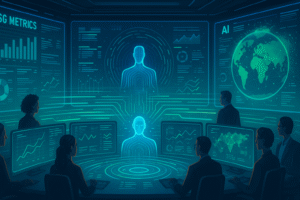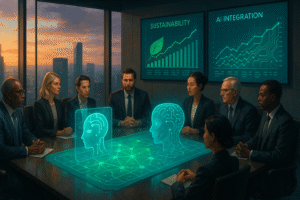The Convergence Imperative: Why AI and Sustainability Must Unite
The business landscape is undergoing a significant transformation. As organizations grapple with the accelerating adoption of Artificial Intelligence (AI), many are also asking critical questions: Is AI sustainable? Is AI helping the planet? The escalating urgency of embedding sustainability into core corporate strategy means these questions can no longer be ignored. The fusion of AI and sustainability is no longer a niche consideration but a fundamental paradigm shift. This convergence imperative is rapidly moving from a forward-thinking ideal to a present-day strategic necessity, demanding structured project approaches for organizations aiming for resilience, efficiency, and long-term value.
This article, the first in a series, explores why this union is critical. We will explore the driving forces compelling this integration, the substantial benefits it unlocks, and how AI, when strategically applied, can indeed contribute positively to environmental and sustainability goals.
 The Inevitable Intersection: Defining the AI-Sustainability Nexus
The Inevitable Intersection: Defining the AI-Sustainability Nexus
Understanding the AI-sustainability convergence begins with recognizing their intertwined nature. AI’s analytical, predictive, and optimization capabilities are well-suited to address the complex, data-rich challenges inherent in achieving sustainability goals. Sustainability has emerged as a strategic priority for businesses, shaping long-term goals and influencing core operations. As AI becomes increasingly urgent, its development must be guided by this principle—serving to advance and align with these long-term sustainability objectives.
This duality means projects must not only explore how AI is contributing with the environment but also ensure AI itself is developed and utilized sustainably, considering its own operational footprint—a key risk factor for any related initiative. While AI’s application can undoubtedly drive sustainable outcomes, the sustainability of AI technologies themselves is an important ongoing consideration.
Catalysts for Convergence: Driving Forces & Project Implications
Several powerful and interconnected forces are accelerating the need for AI and sustainability to unite, directly influencing the initiation and scope of related projects.
1. CEO and Board Prioritization: Globally, a key trend sees leaders placing AI adoption and sustainability performance at the pinnacle of their strategic agendas. This top-level focus is crucial, providing the necessary sponsorship and strategic alignment for successful AI-sustainability projects. Without this executive backing, securing resources and navigating organizational change becomes a significant project risk. According to the Fujitsu SX Survey (August 2024), 76% of organizations ranked AI among the top 5 priorities in their Digital Transformation, with 63% of business leaders believing that increased use of AI will contribute to the success of both digital and sustainability transformation.
2. Escalating Stakeholder Pressure: Diverse stakeholders are compelling organizations to act. Investors are increasingly prioritizing ESG factors and channeling capital accordingly. Customers, too, are demanding ethical practices and sustainable brands, while regulators are implementing stricter disclosure and governance requirements, and employees actively seek purpose-driven work. Effective project management must include robust stakeholder engagement plans to manage these varied expectations and integrate them into project objectives. For example, Barrick Gold’s Pascua Lama mining project was suspended despite extensive outreach, due to environmental and social concerns raised by local communities and indigenous groups—demonstrating how the absence of a social license to operate can result in project failure and reputational damage (INSEAD, 2024).
3. Pursuit of Operational Efficiency and Cost Reduction: AI’s ability to optimize resource use and cut operational costs provides a strong business case for AI-sustainability projects. For instance, AI algorithms enhance energy efficiency, with documented energy consumption reductions ranging from 20-40% in large EU buildings and up to 40% in data center cooling, as achieved by Google using DeepMind. Studies also report average energy efficiency improvements of 15% for companies using AI in sustainability initiatives.
Furthermore, AI also optimizes logistics routes to minimize fuel consumption and predicts maintenance needs to avoid costly downtime and resource waste.
These tangible benefits often serve as key performance indicators (KPIs) and justification for project investment, directly showing how AI can help business and, by extension, the planet through better resource management.
4. Enhanced Risk Management and Resilience: AI significantly strengthens an organization’s ability to anticipate, assess, and mitigate a wide range of risks. This includes capabilities like modeling complex climate data to understand and adapt to physical risks, monitoring supply chains for disruptions or compliance issues, and automating compliance monitoring for ESG-related regulations. Integrating AI for sustainability can thus be framed as a strategic risk management project, building organizational resilience—a critical long-term objective.
5. Drive for Innovation and Competitive Advantage: Organisation today should prioritise the strategic initiatives aimed at enhancing brand reputation, building customer loyalty, and securing a competitive edge. Defining clear innovation pathways and measurable outcomes is key to project success. Consequently, this integration fosters innovation, leading to new sustainable products, services, and business models.
6. Need for Data-Driven Decision Making and Transparency: Projects focused on AI-sustainability integration must prioritize establishing robust data pipelines and analytics frameworks to ensure transparent reporting and inform strategic project decisions. The demand for credible ESG data necessitates AI’s advanced analytical capabilities.
These drivers underscore a shift towards proactive, strategic projects where AI and sustainability are not just operational concerns but engines for innovation and competitive advantage.
 The Symbiotic Advantage: Mutual Benefits & Project Objectives
The Symbiotic Advantage: Mutual Benefits & Project Objectives
The AI-sustainability relationship is symbiotic, creating a virtuous cycle where each enhances the other. This synergy should be reflected in project goals and success metrics, directly addressing how AI is contributing with the environment and whether it’s helping the planet.
How AI Boosts Sustainability Outcomes (Project Benefits):
Resource Efficiency: Beyond energy, AI also optimizes water usage and significantly reduces material waste, with waste reduction averaging around 20% in some contexts, clearly demonstrating a positive environmental contribution.
Cost Reduction: Direct cost savings from these efficiencies are measurable project outcomes.
Improved Financial Performance: While nuanced, higher AI governance maturity correlates with nearly 5% higher revenue growth. Projects can aim to enhance ESG scores, which some studies link to market value.
Enhanced Productivity: AI-driven productivity gains can free up resources, a tangible benefit for project resource management.
How Sustainability Drives Responsible AI Innovation (Project Considerations): Addressing complex sustainability challenges through AI stimulates innovation. Importantly, a sustainability focus often leads to more ‘Responsible AI’ practices, as organizations with strong ESG commitments are more likely to build ethical frameworks and mitigate bias—essential considerations for project governance and risk management in AI deployment. This responsible approach is key if the answer to “is AI sustainable?” is to be affirmative in the long run.
Key Takeaways for Leaders & Project Sponsors
- The imperative to converge AI and sustainability offers critical insights:
- Strategic Project Initiation: This convergence is a strategic necessity, requiring formal project management approaches from the outset to explore AI’s environmental contributions.
- Stakeholder-Driven Scope: Project objectives must align with diverse stakeholder expectations and the multiple drivers for integration.
- Measurable Benefits: Projects should aim for quantifiable outcomes in efficiency (like the cited energy and waste reductions), cost, risk mitigation, and innovation.
- Ethical Project Governance: A sustainability focus inherently supports responsible AI development, a key project management principle in ensuring AI’s positive impact.
Conclusion: Embracing the Union Through Strategic Projects The union of AI and sustainability is an urgent imperative offering substantial benefits. This convergence requires a deliberate, project-based approach to re-architect business value, moving beyond ad-hoc efforts. By actively exploring how AI contributes to environmental well-being and implementing strategic initiatives, organizations can leverage AI as a powerful force for planetary health. Strategically managing this integration with well-defined projects, clear objectives, and robust governance will enhance performance, build resilience, and position organizations to lead in shaping a sustainable and intelligent future. The time for strategic action and project initiation is now.
Our next post will explore specific industry use cases and examples of this transformative union.
Bibliography
1. Fujitsu SX Survey (August 2024) – 76% of organizations ranked AI among the top 5 priorities in their Digital Transformation, with 63% of business leaders believing that increased use of AI will contribute to the success of both digital and sustainability transformation. Source: https://global.fujitsu/en-global/about/vision/leadership-challenges/sustainability-transformation-survey-2024
2. INSEAD (2024) – Barrick Gold’s Pascua Lama project exemplifies the consequences of failing to earn stakeholder trust and a social license to operate, despite numerous engagement attempts. The project faced legal and reputational setbacks due to strong opposition from local communities and environmental groups. Source: https://knowledge.insead.edu/responsibility/stakeholder-strategies-make-or-break-sustainable-business
3. Gartner Survey (June 2024) – 69% of CEOs view sustainability as a growth opportunity and a top business priority, underscoring the strategic imperative of integrating sustainability with emerging technologies like AI. Source: https://www.gartner.com/en/newsroom/press-releases/2024-06-05-gartner-survey-reveals-69-percent-of-ceos-view-sustainability-as-a-growth-opportunity
4. PwC Report (2024) – AI is increasingly viewed as a key enabler in driving sustainability goals, with companies investing in AI to improve ESG data management and operational efficiency. Source: https://procurementmag.com/sustainability/pwcs-2024-report-strategic-growth-ai-investment-net-zero
5. Forbes Study (Sept 2024) – C-suite executives acknowledge AI’s significant role in advancing sustainability, but many face challenges in operationalizing this synergy effectively. Source: https://www.forbes.com/sites/oludolapomakinde/2024/09/25/c-suite-leaders-say-ai-drives-sustainability-but-they-are-unsure-how-to-use-it
About the Authors:
Merv Wyeth, Sustainability Community of Action (SCoA) Lead
Sam Leung and Leila Moses, Sustainability Community of Action (SCoA) Members


